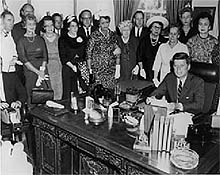
President Kennedy Signs the Equal Pay Act, June 10, 1963.

Forty years ago, on June 10, 1963, President John F. Kennedy signed the Equal Pay Act (EPA) into law, paving the way for the long march toward equal opportunity in the workplace. At the time, full-time working women were paid on average 59 cents to the dollar earned by their male counterparts, according to government data.
At the White House signing ceremony, President Kennedy said the EPA:
"Adds to our laws another structure basic to democracy" and "affirms our determination that when women enter the labor force they will find equality in their pay envelope."
The EPA is the oldest workplace civil rights law enforced by the U.S. Equal Employment Opportunity Commission (EEOC), predating passage of the landmark Civil Rights Act of 1964 by one full year. Once enacted, the EPA was originally enforced by the U.S. Department of Labor with jurisdiction being transferred to the EEOC in 1979.
The EPA prohibits discrimination on the basis of sex in the payment of wages or benefits, where men and women perform work of similar skill, effort, and responsibility for the same employer under similar working conditions. Under the EPA :
In the EPA's "Declaration of Purpose," Congress wrote that sex-based pay discrimination:
These factors are just as relevant today as they were in the 1960s.
See also:
This page was last modified on June 10, 2003.